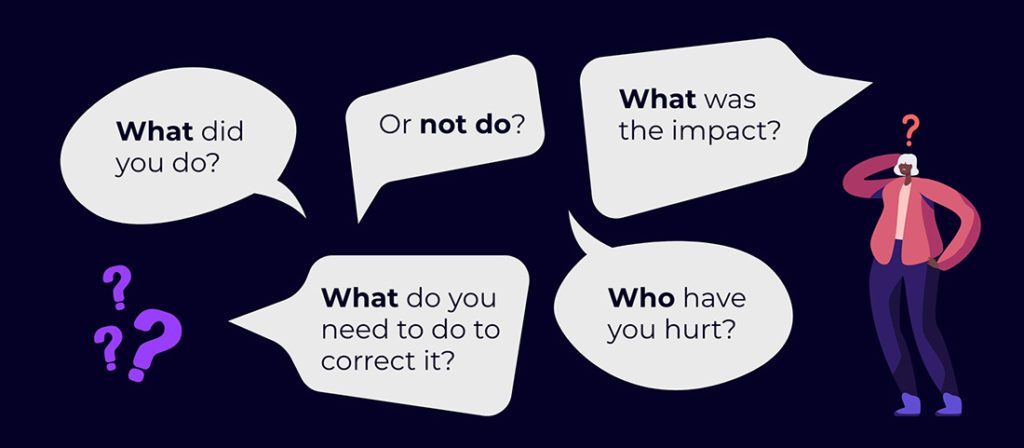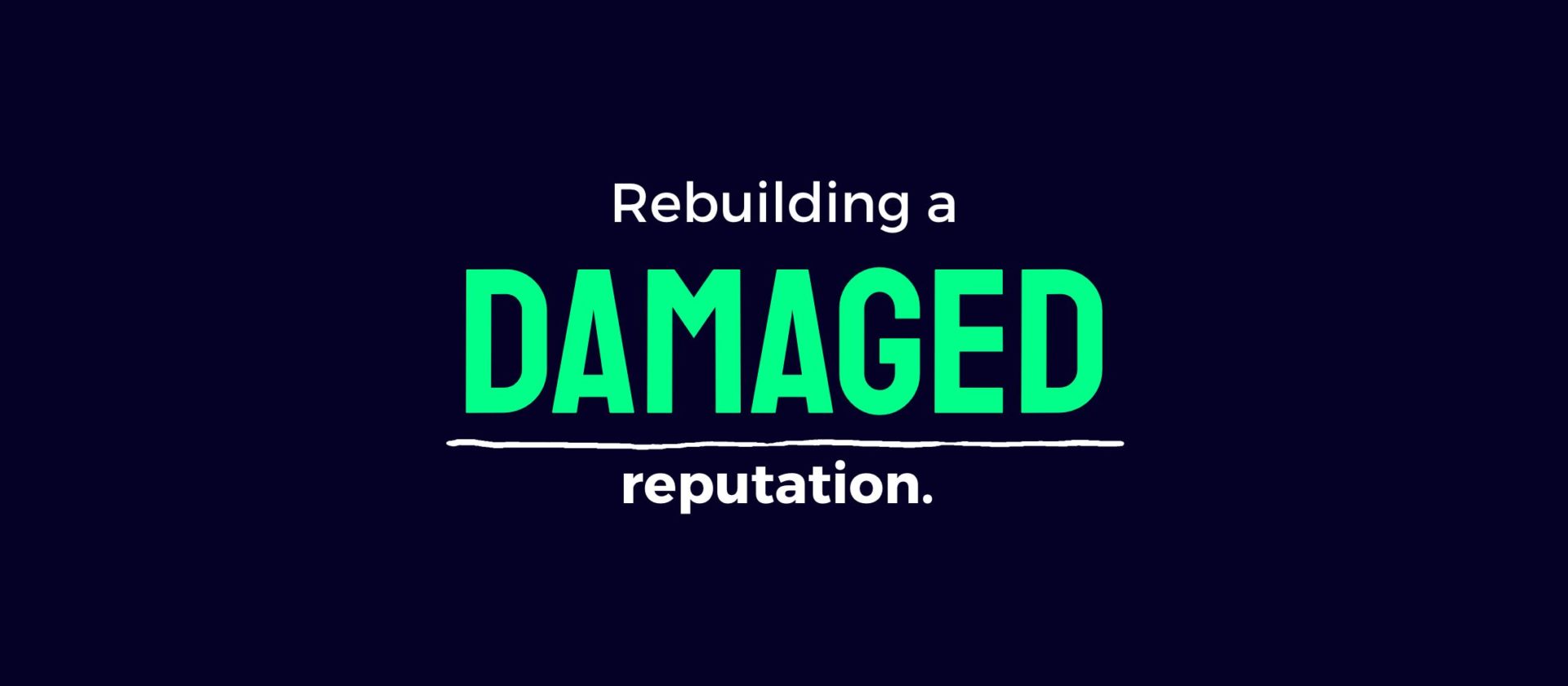Rebuilding a damaged reputation takes great communication. Whether your business has had a small slip up or made a massive mistake, our presentation survival skills could have you emerging from this scandal unscathed.
You’ve been working tirelessly to positively influence your brand perception. You’ve created a reputation for honesty, great service, and reliable products. But just one indiscretion can cost you your relationships and future opportunities. It can affect the confidence of everyone in your team. And have them jumping ship before the fire has even spread. Rock bottom sure does feel a long way down when you’re staring up at the journey back. But it is possible to claw your way to the top.
It all starts with a speech
“It takes 20 years to build a reputation and five minutes to ruin it.”
Warren Buffett
When your company reputation takes a hit, you can feel powerless as others trash your brand name. It can feel as devastating as if it was your own reputation on the line. Of course, a company indiscretion can be down to an individual’s wrongdoing. Perhaps someone shared something inappropriate on the company’s social media. Maybe a representative spoke out of turn in a high-profile media interview. But the majority of mistakes can often be traced back to the company’s core processes, values, and culture.
Whether your brand took an ill-advised stance on a social issue, made a bad business decision, or joined forces with a questionable partner on a marketing campaign, it is going to be a challenge to wake up from this public nightmare. Everything you’ve worked for is on the line. While every strategy to rebuild trust will be different, many of them need to start with a public address. And getting this right is paramount to the overall success of your redemption.
Here’s our advice as to the best way to own up to your mistakes and how to write a public apology that may just save your bacon.
Discovery for rebuilding a damaged reputation
It’s important to move as fast as possible following an indiscretion. However, you don’t want to just jump in front of a live audience and hope the right words fall out of your mouth. You need to plan your speech – and your overall strategy – in a no-holds-barred discovery session.
Repairing a damaged reputation begins with assessing the situation and the damage – and being brutally honest. What did you do? Or not do? What do you need to do to correct it? What was the impact? Who have you hurt?

Be realistic when setting your goals in this session. An idea can change the world, but you can’t hang your entire reputational reboot on one speech. Before you start writing, make sure you’ve set a realistic goal as to what you want to achieve by speaking. Understand the elements you can and cannot control. Focus your attention where you can make a difference to the lives of those you’ve wronged.
You will need all key stakeholders in this discovery meeting. This is to make sure no stone is left unturned, and everyone knows the plan moving forward. It’s also wise to get a second opinion from a few trusted friends, or outside eyes. They will be able to give you a balanced viewpoint on what you’ve done, and how to fix it. An objective point of view can offer crucial perspective on the issue at hand.
A great way to discover the impact of your actions is to read what’s being written about your hiccup. And don’t just turn to the media, as they’re unlikely to be directly impacted. Set up Google alerts to read what the general public is saying. Search for your brand name on social media. Get to understand the problem better, through the eyes of your customers. After all, a good apology is always about the wronged party.
Think about your audience first
Johnson and Johnson knew this all too well when contaminated Tylenol put its customer’s lives at risk. By responding quickly to recall over 31 million bottles from store shelves, without a concern for profit, it not only regained the trust of its customers when everyone believed the brand to be on its way out, but it also regained a large percentage of its market share within a year.
The case for keeping your mouth shut
While we’re talking about goals and discovery, let’s address the option to not say a word.
Not every redemption story needs to leverage a platform. In some cases, pulling away from the public view is a better approach. Sometimes, if emotions are too high, silence can be golden. Then, when the hubbub has resided and people have had time to calm down, you can issue a measured and reasoned response to greater success.
This is especially important when thinking about your channels for communication. When people are upset, hurt, or angry, they lash out. Give them a keyboard, and they will go for it, holding nothing back. Issuing one official apology speech is the right move most of the time. However, engaging with angry people online can often derail the hard work you’ve put into that well-thought-through address.
Instead, monitor your social media. Use it as a feedback tool and a way to measure which way the meter is trending, both before and after your apology.
Storytelling for rebuilding a damaged reputation
Classic storytelling is an essential skill that can help you to win more business, connect with people, build stronger teams, and tell edge-of-your-seat anecdotes down the pub. Oh, and storytelling is vital in rebuilding a damaged reputation. You can use the same techniques to craft a classic novel as you can to write public apologies. Here are our storytellers top tips for your redemption story:
Current situation
“‘I’m sorry’ are the two most healing words in the English language.”
Dr. Lerner
Every great story starts by establishing common ground and getting everyone on the same page. In an apology speech, you can establish common ground by admitting your wrongdoings and – this part should be obvious – saying you’re sorry. Some of your customers may not know the full story yet, so it’s important to clarify what happened, but don’t use this narrative as a way to issue an excuse instead of an apology. Just stick to the facts.
Write your speech from a place of authenticity. Your audience will know if your regret is not genuine, and – no matter how poetic your writing, or how many fancy words you use – they just won’t buy it. In fact, you’ll end up making things worse. Don’t hide behind evasive language or – worse – gaslight your customers into thinking they’ve misunderstood the situation. Be forward, frank, and sincere. A good way to do this is to think about how you’d apologise to a loved one, and channel that same emotional language and tone in your public address.
Because of the vulnerable position an admission of guilt can put you and your company in, many brands try to trick their customers by issuing a statement that takes the form of an apology, but never actually accepts responsibility. This is not only a cowardly move, but it’s not fooling anyone. Research has shown that customers feel a restored sense of fairness when brands apologise, but this same feeling doesn’t occur when a non-apology is offered instead.
Own up to your mistakes
“I did not have sexual relations with that woman.”
Bill Clinton
Humans are hard-wired to defend themselves, but denying responsibility will only damage your credibility. Like they say, there’s no smoke without fire, so even if your part in the event has been blown out of proportion, start by admitting the part you did play. Take direct, unequivocal responsibility and put your audience before your innate need to be right.
Most people – even a lot of those who weren’t alive at the time – can recall how badly Bill Clinton handled early allegations of his affair. Not only did he deny this indiscretion, but he also played the victim who was just trying to protect his family against the ‘endless’ investigation. Though he later admitted everything and apologised, it was too little, too late. The damage was done, and the public couldn’t trust Clinton.
Solution

When you’ve made a mistake, it’s not enough to say sorry. You need to restore trust by telling your customers how you’re going to make it right, and how you will never make the same mistake again. You need to lay out your plan of action, and walk them through the steps – and timescales – to positive change.
Imagine a version of your brand that’s highly regarded and is not only free from this damaged reputation, but has done a 180 entirely. How does that brand behave? How does it communicate? What are its values? What does it do for its employees, customers, and community? Paint this picture of a brighter future for your audience, and go into detail as to how you’ll get there – and by when.
Audience interaction
The best presentations are a dialogue, not a monologue and, while the actions that got you here may have been accused of being ignorant to the needs of your audience, you don’t want to make that mistake again.
Instead of just preaching to the public about how you’re going to do better, ask for their involvement. Talk to customers about the problem and what they’d like to see you do to fix it. Deliver on these actions and compensate anyone who helps you. They should not be expected to give you advice for free.
Brighter future
Even though your main objective is to apologise with sincerity and make sure your audience feels heard and understood, there’s no reason to overplay your mistake or add fuel to the fire by pointing out further negative impacts they hadn’t even thought of. Instead, lean in on the positives and be sure to outline everything you’ve learned from this situation.
And what you do next matters. Once you step down off that stage, you need to make sure your actions speak for you. You need to deliver on every promise you made, and you need to build a better brand. Nothing prolongs reputational damage more than continuing the same values, behaviours, policies, and processes that led you to this sticky situation. And the eyes of the world will be watching now, waiting for you to slip up again.
Don’t give them the satisfaction.
Move fast. Meet every milestone. Go above and beyond to show that you meant every word. And remember, there is no end date for this project. This is a permanent change that must be made at every level of your business. It needs to be sewn into the fabric of your brand. And consistently actioned without asking for a pat on the back. You, as the leader of this change, need to consider how you can guide your people through. It’s only through ingrained behaviours that your brand will succeed in rebuilding its damaged reputation.
Stop the scandal
During an investigation, the Environmental Protection Agency found that many Volkswagen cars had a “defeat device” installed. This software could detect when the cars were being emissions tested, changing the performance accordingly to improve results. Once the news broke, VW failed to act decisively or quickly to rebuild their reputation.
Three years later, the company was still facing new rounds of litigation by those impacted.
VW broke the trust of its customers and rubbed salt in the wound by denying the allegations. And the impacts to the business were clear. Volkswagen suffered its first quarterly loss in 15 years. And the company ended up spending billions when its attention did turn to rebuilding the damaged reputation.
If your company is currently under scrutiny – no matter how minor – you need to look to the likes of Volkswagen and Clinton as how not to behave. Hold your hands up, say sorry with meaning, and work hard to show your customers your words are anything but empty. Only then will you have a chance of rebuilding your damaged reputation.
Seek outside expertise
At Buffalo 7, our purpose is to harness the chaotic energy of a raw idea and transform how the world experiences it. But not all ideas are world-changing inventions or exciting business developments. Sometimes the idea has to be to fix that which is broken.
Transformative experiences are all about creating that next-level communication that people don’t just hear, they feel. If you want your audience to feel just how sorry you are, consider getting in touch today.



